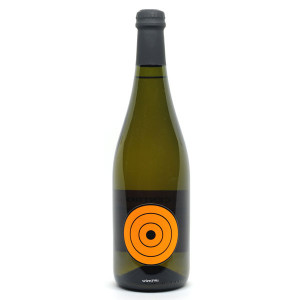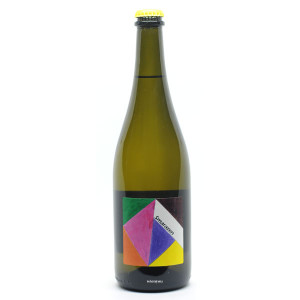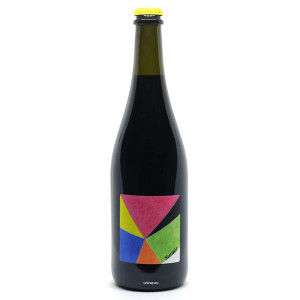Mirko Mariotti's “Centro” Orange Label is a refermented wine in a bottle that comes from Garganega grapes macerated on their skins for 10 days. A wine that expresses freshness accompanied by compact and material bubbles.
Region: Emilia Romagna.
Grapes: Garganega
Alcohol content: 12.5%.
Aging: Refermentation in the bottle.
Contains sulfites
Mirko Mariotti's Treb is a fresh and savory wine obtained from Trebbiano grapes with the method of refermentation in the bottle. The grapes come from vines over 100 years old which are located just 300 meters from the Adriatic Sea. Spontaneous fermentation with short maceration time on the skins and bottling for refermentation without adding anything. Never foul. Refinement of 4 months in the bottle before release. Very treb, very delicious. Enjoy the sun with a light meal and lots of positive people.
Region: Emilia Romagna.
Grapes: Trebbiano.
Alcohol content: 12.5%.
Aging: Refermentation in the bottle.
Contains sulfites
The Sèt and the Mèz appear to be a light colored cerasuolo with a beautiful foam. A nose bouquet is a bouquet of roses, delicate but delicious, and fruity notes. At the sip it expresses freshness accompanied by compact and material bubbles.
Region: Emilia Romagna.
Grapes: Fortana
Alcohol content: 12,5%.
Aging: Refermentation in the bottle.
Contains suflites
Smarazed is a sparkling wine much appreciated for its freshness and flavor, which comes from a blend of Trebbiano Romagnolo and Malvasia di Candia. It has a slightly turbid straw yellow color with a good effervescence. On the nose intense and fine aromas of floral and fruity scents are released. In the mouth it is dry, warm, fairly soft but fresh and tasty, with a good finish.
Region: Emilia Romagna.
Grapes: 70% Trebbiano Romagnolo, 30% Malvasia di Candia.
Alcohol content: 12%.
Aging: Refermentation in the bottle.
Contains sulfites
Mirko Mariotti's Turnè is a sparkling wine obtained from refermentation in the bottle without "disgorgement" based on Trebbiano and Grecheto grapes. "Sur lie" wine, to be served clear or cloudy depending on personal tastes. It goes well with appetizers of Emilian cured meats or in company with friends.
Region: Emilia Romagna.
Grapes: Trebbiano and Grechetto.
Alcohol content: 12.5%.
Aging: Refermentation in the bottle.
Contains sulfites
The Cuveè 60 is an intense and complex classic method sparkling wine based on chardonnay. 60 months aging on the lees. It has a golden yellow color with fine and persistent perlage. On the nose aromas of bread crust and evolved aromas of yellow paste fruit. On the palate the entrance is decided with slightly smoky notes that are accompanied by buttery, fat, full-bodied and very persistent hints.
Region: Lombardy.
Grapes: Chardonnay.
Alcohol content: 12.5%.
Aging: 60 months aging on the lees.
Contains sulfites
The "Cuveè Nature" by Nicola Gatta is a satisfying and carefree sparkling wine made from Chardonnay and Pinot Noir grapes, with grapes from vineyards located 400 meters above sea level in Gussago. In the cellar, the vinification takes place through soft pressing of the grapes and spontaneous fermentation with indigenous yeasts. Refine on its lees for 30 moons.
Grapes: 80% Chardonnay, 20% Pinot noir.
Alcohol content: 12%.
Aging: At least 30 months on the lees.
Contains sulfites
"Surlie" by Mirko Mriotti is a lively and dynamic sparkling red wine that comes from grapes of Fortana in purity. Purplish red color, slightly turbid with a good effervescence. On the nose the aromas are intense and fine with floral and fruity scents. In the mouth it is dry, warm, fairly soft but fresh and tasty, with a bitter finish.
Region: Emilia Romagna.
Grapes: Fortana.
Alcohol content: 12.5%.
Aging: Refermentation in the bottle.
Contains sulfites
Ripa di Sopravento is a sparkling wine obtained from white grapes with the method of spontaneous refermentation in the bottle, as per the centuries-old tradition in Emilia and beyond. The nose is aromatic, with notes of fruit, hints of cream and coconut. In the mouth it is structured, with nice carbonic, very mineral, very tasty and fresh that invites to drink, nice finish.
Grapes: White grapes.
Alcohol content: 12%.
Aging: Refermentation in the bottle
Contains sulfites
“Uva d'oro” by Mirko Mariotti is a sparkling wine made from Fortana grapes obtained with long re-fermentation in an autoclave. A straight and dynamic wine on the sip, a bubble that envelops the palate, where aromas of small red fruits such as blackberry and strawberry stand out. A finish of good flavor that attracts another taste.
Region: Emilia Romagna.
Grapes: Fortana
Alcohol content: 11,5%.
Aging: Refermentation in the autoclave.
Contains suflites
II "60 Lune" by Nicola Gatta is a rosé Classic Method sparkling wine of great intensity and finesse obtained from Pinot Noir grapes. Maceration on the skins for a few hours and then spontaneous fermentation. Aging on the yeasts naturally present on the skins lasts for 60 moons, sixty months
Grapes: Pinot noir
Alcohol content: 12%.
Aging: At least 70 months on the lees.
Contains sulfites
II "70 Lune" by Nicola Gatta is a Blanc de Noirs Classic Method sparkling wine of great richness and depth obtained from Pinot Noir grapes. The austerity of Pinot Noir balanced by 70 moons spent on the yeasts results in a structured but very balanced wine.
Grapes: Pinot noir
Alcohol content: 12.5%.
Aging: At least 70 months on the lees.
Contains sulfites
The "50 Lune" by Nicola Gatta is a complex, intense and rich Classic Method Blanc de Blancs sparkling wine obtained from Chadonnay grapes grown in Gussago, one of the few areas of Franciacortino where the limestone part is dominant, then transmitted to the roots that in the wine is transformed into acidity and minerality that is great freshness of drink. After refermentation in the bottle, the liquid rests on the fine lees for about 50 months / moons.
Grapes: Chardonnay.
Alcohol content: 12%.
Aging: At least 50 months on the lees.
Contains sulfites
Ombretta Mosso Rosato is a sparkling wine obtained with the use of both briefly macerated white grapes and directly pressed red grapes. After the first fermentation, the wine rests for the whole winter in a cool place in old wooden barrels. With the arrival of spring and the rise in temperature, the second spontaneous fermentation in the bottle begins. A wine characterized by a pleasant and slender drink, with aromas that refer to ripe red fruits and floral notes.
Grapes: Blend of local white and red grapes.
Alcohol content: 11%.
Aging: Refermentation in the bottle.
Contains sulfites
Camillo Donati's Trebbiano is a different refermented bottle than usual. Sparkling, surprising, decisive, agile and snappy. Pure bottled joy.
Region: Emilia Romagna.
Grape variety: Trebbiano.
Alcohol content: 12%.
Aging: Refermentation in the bottle.
Contains sulfites
















